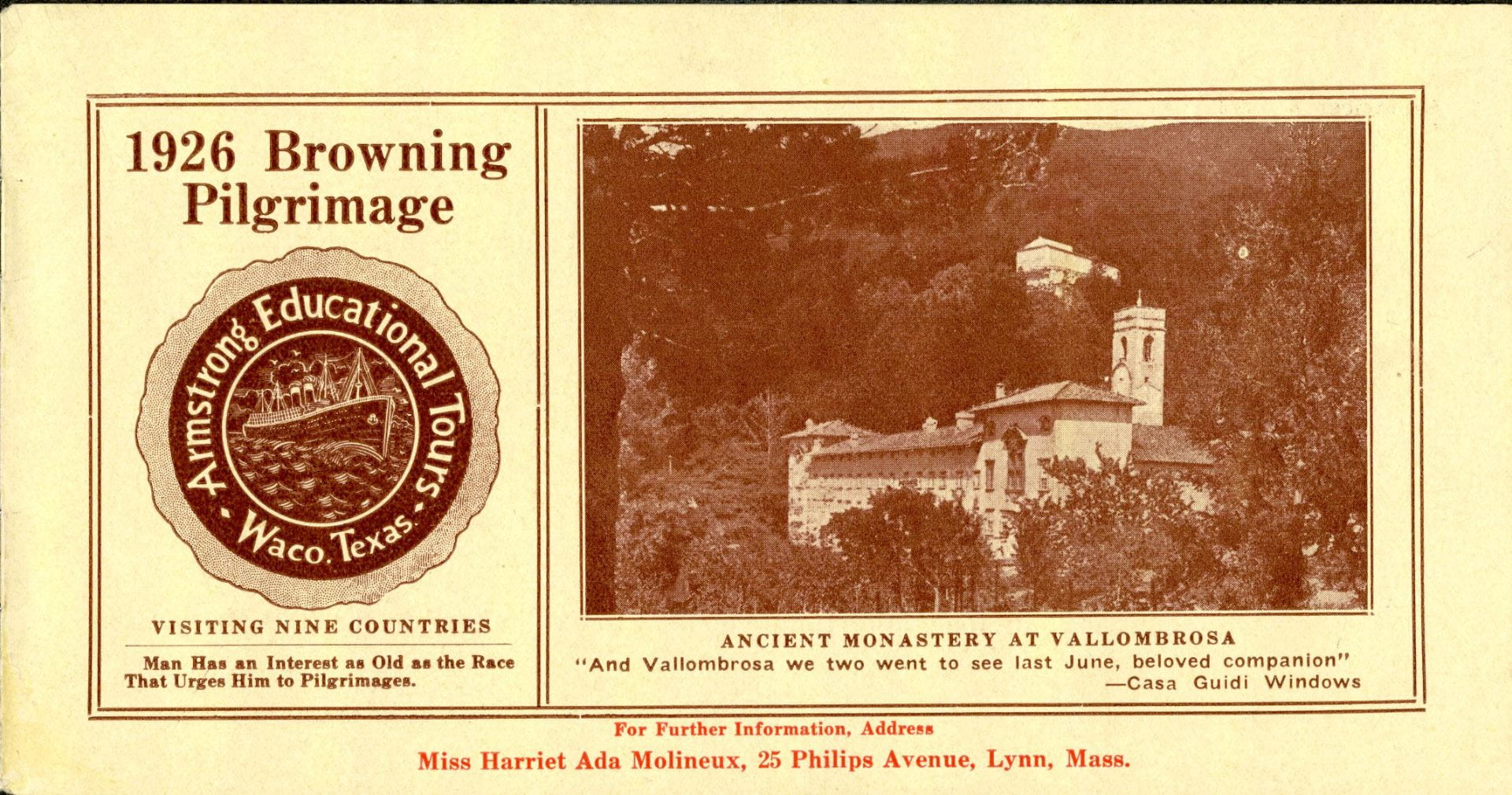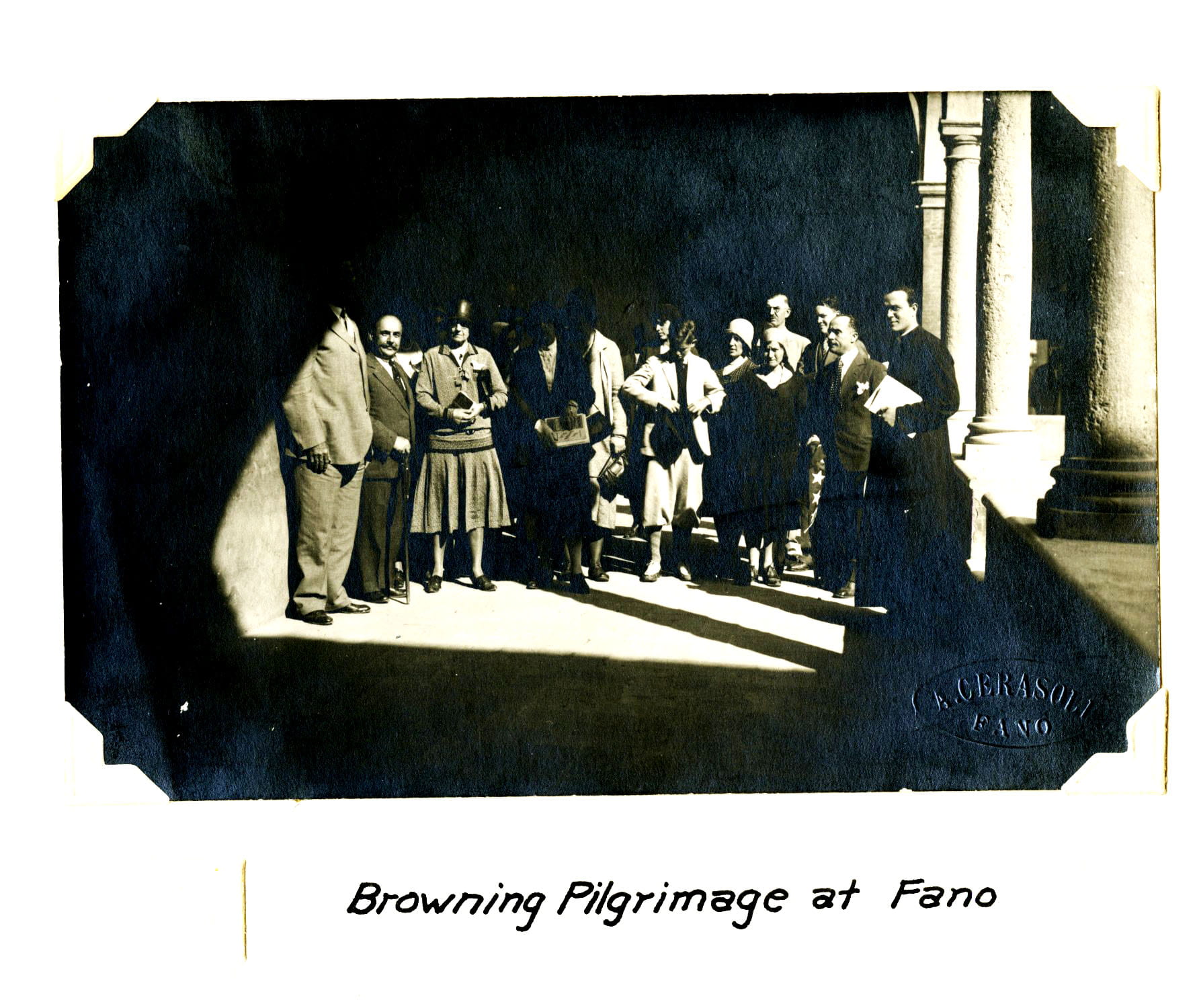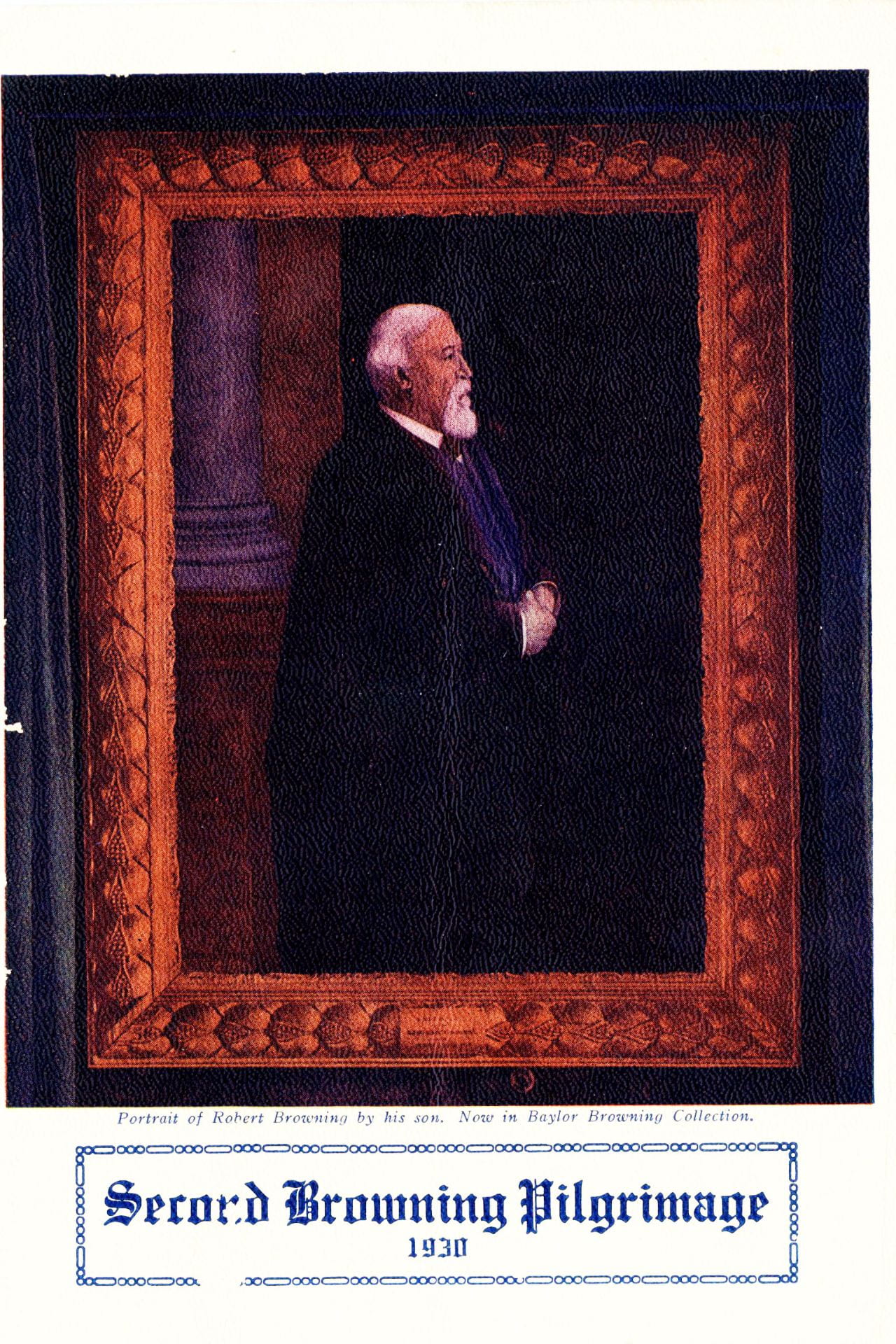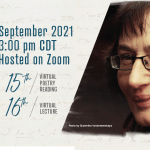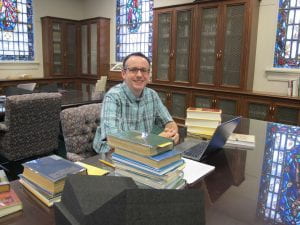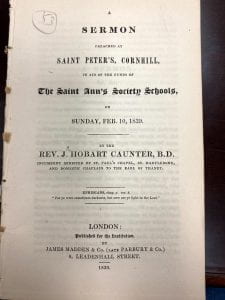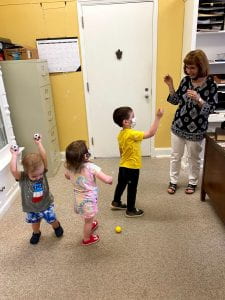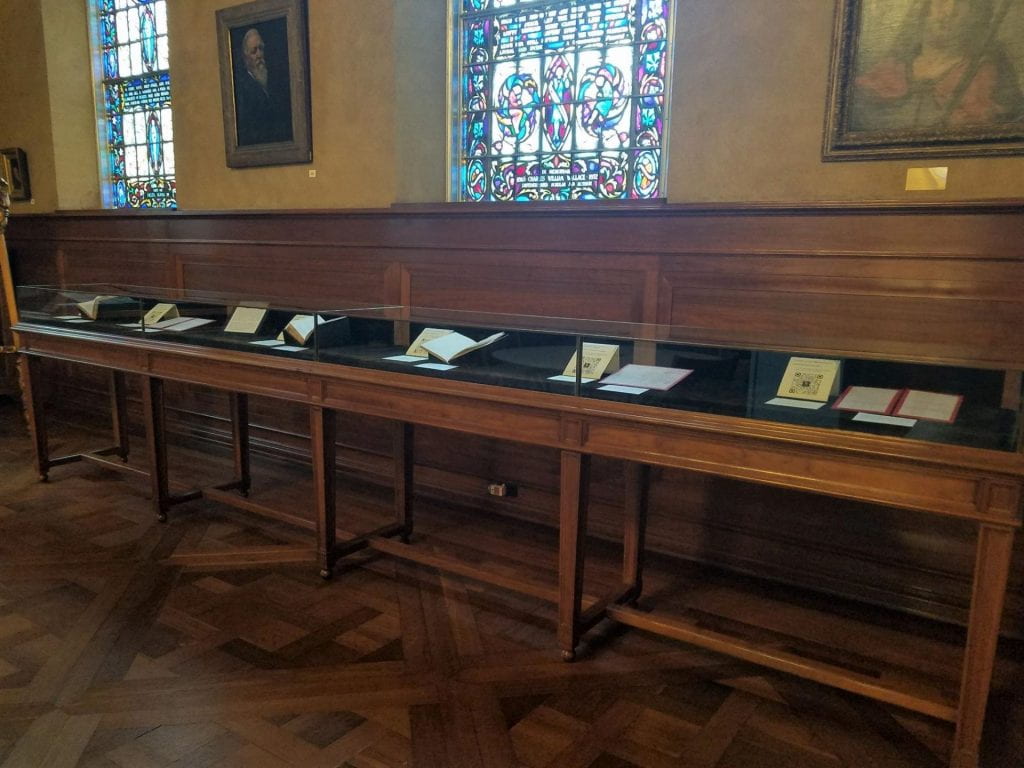By Lindsey N. Chappell, PhD, Assistant Professor of English, Georgia Southern University

Dr. Lindsey N. Chappell in the Belew Scholars’ Room at the Armstrong Browning Library.
It’s always a good idea to have a plan before going to an archive. This is the advice I give my students because, as I tell them, funny things happen to time in these places. You compress your research, sprinting through (or frantically photographing) primary sources, and new ideas and objects will lead you into rabbit holes. You will be perpetually perplexed about what month it is. You will lose an entire Wednesday. In an archive, then, you want to be flexible enough to accommodate exciting discoveries but prepared enough that you don’t waste time wondering where to start.
I believe this is, in general, good advice. I’m sure someone else gave it to me (probably Helena Michie, whose graduate seminar first required me to work with archival material). And being a responsible scholar—is it possible to fail grad school retroactively?—I did have a plan when I applied for a visiting fellowship at the ABL. I swear.
However, finally arriving (fully vaccinated!) at Baylor in May 2021, a year after my originally scheduled visit, my research projects had changed. I’d moved on from some projects and changed priorities with others. I had an initial research question, but I wasn’t sure what I would do with the things I found, especially since my book project (currently titled Temporal Forms: British Heritage Discourse and the Nineteenth-Century Mediterranean) was a year—ok, a pandemic year—further along than when I had originally planned my visit.
My book is about three Mediterranean regions that were central to the making of Western cultural heritage—Italy, Greece, and the so-called “Holy Land”—in British literature. The Mediterranean, I argue, enables us to ask how historical narratives intervened in geopolitics, how antiquarianism sparked scientific innovation, and how classical and biblical heritage shaped British imperialism. I trace the contours of what I call “heritage discourse”—narrative that constructs or challenges imperial identities by reshaping antiquity—across nineteenth-century British texts about the Mediterranean. Heritage discourse, I argue, functions via time, and often in counterintuitive and paradoxical ways. If assertions of political, cultural, and eventually racial supremacy were the end of this Mediterranean heritage discourse, then time was the means through which it could be (and perhaps still is) deployed and resisted. Temporal Forms reveals how recalculations of time on a geological scale, subsequent new histories of human civilization, radical reinventions of time, trajectories of cultural development, and growing skepticism toward long-held Enlightenment and biblical accounts all converged in British representations of the Mediterranean.
When I applied to be a visiting fellow at the ABL, I planned to start working on the Italy section of Temporal Forms and especially to write a chapter about Florence. My initial research questions were: What are the temporal forms that organize Florence and its inhabitants/visitors? How did people imagine/conceive of Florence around the Risorgimento, and how did that shape the ways they experienced time and constructed it narratively? By 2021, though, I had already decided to focus the Florence chapter on syncretism as a temporal form, and I had a working draft completed. Still, I wanted to see what I could find about the Anglo-American community in Italy and especially the abstract idea of “liberty” in the late 1850s and early 1860s, which I discuss at the end my Italy section. I don’t write much about the Brownings themselves, whose Italy connections have been so well trod in scholarship already (though EBB’s Poems before Congress and RB’s Old Pictures in Florence inform my Italy section, and I looked at editions of both in the ABL). Because the Brownings lived in Florence, though, their archives contain a wealth of material on the broader nineteenth-century Anglo-American community in Italy.
During my fellowship, I read material by and about: John Ruskin, Arthur Hugh Clough, Vernon Lee, and the American sculptor Hiram Powers. I hunted for the Horner family, who feature in my Florence chapter, and Sarah Parker Remond, a Black anti-slavery activist who moved to Florence in 1867 and became a physician. In the case of the former, I found materials in the 19th-Century Collection, the Browning Letters, and especially in the newspaper archive databases available through Baylor (for example, the obituary Susan Horner wrote for her father, reviews of her many publications on Italian art and politics, information on societies and people she mentions in her journals). In the case of the latter, I found no trace (did Remond cease speaking publicly after the US Civil War? After she moved to Italy? Or did the Italian newspapers not report on her the way the British and American ones had? I couldn’t find her in Florence, though I did find a letter she published in the American National Anti-Slavery Standard written from Florence in 1866).
In my hunt for Remond, the Horners, and the wider Anglo-American community in Florence, I consulted the ABL’s holdings of the Florentine newspaper La Nazione. But “consulted” is reductive of the physical experience of accessing and reading La Nazione. The bound volumes are huge. And heavy. And crumbling. I admired Jennifer Borderud, Director of the ABL, even before I witnessed her fearlessness and enthusiasm in the pursuit of knowledge. She didn’t weep when I requested these volumes—didn’t even flinch—but, as she explained, fetching them was a multiple-person operation. I accompanied Jennifer (and a sturdy cart) into storage where we proceeded to wrestle several volumes out for my perusal.
I have gotten used to (all right, spoiled by) digital newspaper archives. Yes, of course I will romanticize the material artifact, the smell and feel of decaying paper, as much as any self-respecting Victorianist. I love old books. But part of me—the part aware of my month-long fellowship steadily ticking away—longed for a search box. La Nazione was founded in Florence by Bettino Ricasoli in 1859 as a daily political newspaper. For me, that meant skimming 365 numbers per year of small print in Italian, hoping I would notice when my eyes passed over a name or event of interest to me.
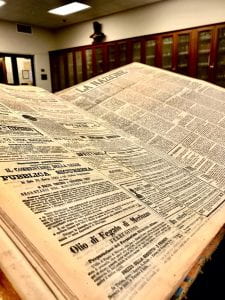
A volume of La Nazione containing part of 1859—a research endeavor.
Nineteenth-century issues of La Nazione organize news geographically into “Notizie Italiane” (“Italian News,” subsectioned by regions within Italy, in its earliest numbers still an aspirational national designation) and “Notizie Estere” (“Foreign News,” subsectioned by country and/or city or region—the scale of the geographical designations is sometimes irregular). An “America” section might contain US Civil War news and news from Peru; sometimes there is a very specific location heading (such as “New York” or “Hong Kong”) and sometimes a more sweeping designation (“Asia”). And sometimes broad headings like “France” contain only news of Paris. I am endlessly interested in what might be contained in these kinds of geographic labels (and what might be left out).
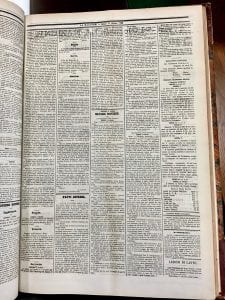
La Nazione 11 October 1862, reporting the Emancipation Proclamation in the U.S. alongside news from Paris and London about Risorgimento efforts.
Of special interest to me were the London news segments; in the early numbers especially, these were often Italian translations of what British periodicals were saying about Italy, including reprints of calls for English readers to support the Italian independence efforts. Similarly, much of the “America” news reprinted selections from the Italian-American paper Eco d’Italia (published in Italian in New York City), making La Nazione’s reprints an echo of an echo as they captured nineteenth-century immigration networks and shared concerns for “liberty” as Italy pursued independence from foreign rule and the U.S. fought a civil war over slavery.
And there was also news that, to me, bore no immediate relevance to Italian politics: a lecture given at the Museum of Natural Science in February 1867 showcased dicksonia antarctica, the Australian tree fern (I do love a nice tree fern). The issue for 17 June 1873 noted that Great Britain had a population of 22,712,000 in 1871 and 135,004 convictions for drunkenness (I have no idea why this might have mattered in Florence, but I look forward to your emails explaining it). I did say there were rabbit holes.
Nor were diversions limited to the contents of La Nazione. What is the use, one might ask, of having a research plan when there is a book in the archives called Strange Visitors written in 1869 “by the Spirits of Irving, Willis, Thackeray, Bronte, Richter, Byron, Humboldt, Hawthorne, Wesley, Browning, and others now dwelling in the spirit world. Dictated through a clairvoyant, while in an abnormal or trance state”? Did I know Charlotte Brontë posthumously dictated a short story called “Agnes Reef” to a clairvoyant? As the editor Henry J. Horn describes, “For weeks and months the unseen visitors were punctual to their appointments, and this novel-mode of book making proceeded steadily in interest and variety until the volume was completed” (viii).
You may be thinking, to borrow a phrase from Bleak House, “What connexion can there be?” But I did plan to research temporality, and here was an assertion that spirits observed human-time—at least while Horn was making his book (which went through at least three editions).
From Italy (and Strange Visitors), I moved on to Austen Henry Layard, Harriet Martineau, and biblical archaeology and history, gathering material for the “Holy Land” section of Temporal Forms. In addition to books, I consulted the ABL’s theological tracts collection. Here were many texts engaged in British efforts to find and to date biblical sites like Nineveh. I looked at a lavishly illustrated American book, Antiquities of the Orient Unveiled, by M. Wolcott Redding. Despite the creepy pun on “Unveiled,” this book engages the scientific rhetoric of nineteenth-century archaeology. As in Layard’s publications on Nineveh, there is here an insistence on describing historical sites as they are “now,” while most of the illustrations are strangely timeless. The first chapter, “Jerusalem,” includes two facing images. The first (and largest, consisting of a fold-out page) shows “Jerusalem as it was in the time of Solomon—Population 150,000.” The second, “Jerusalem as it is—Population 20,000.” It’s an invitation to compare then and now, but the comparison is thwarted by the difference in the pictures’ sizes (does the larger picture reflect the larger population of “old” Jerusalem? Its greater importance for readers of Antiquities who are gazing on this “Orient” “Unveil[ed]—with or without consent?) and in their different orientations (old Jerusalem is formatted horizontally; new is formatted vertically, so a reader would have to rotate the book to look at each, meaning either then or now is always the wrong way up.
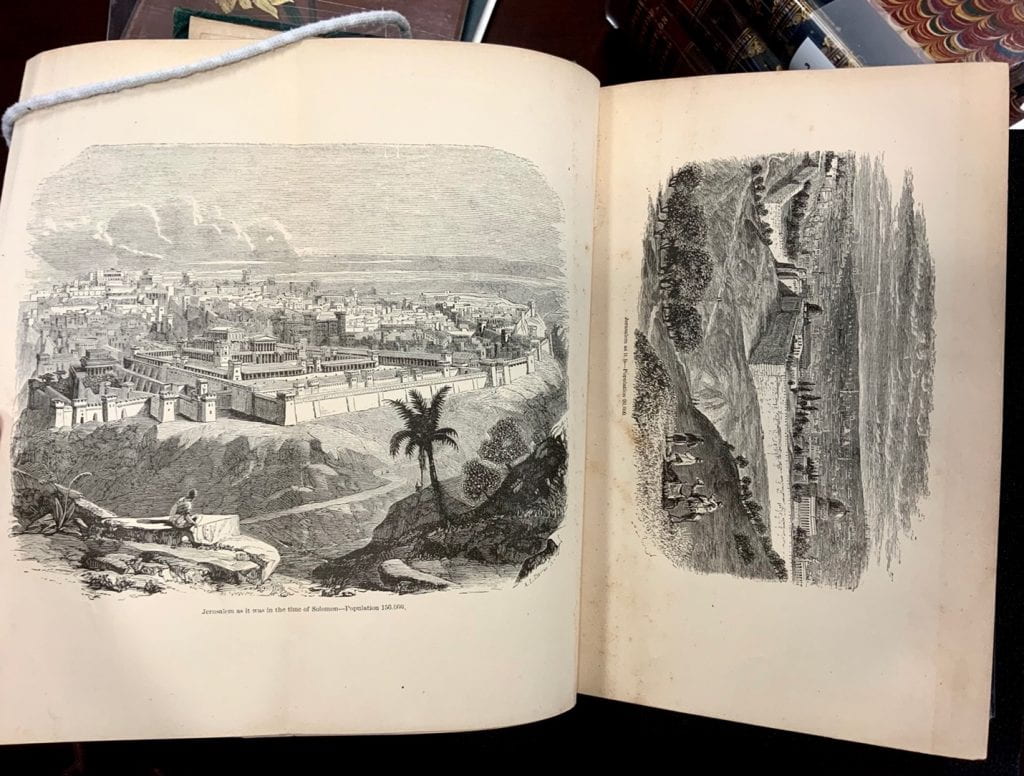
Two pictures of Jerusalem, Antiquities of the Orient Unveiled, by M. Wolcott Redding
Many materials I accessed in the archive were digital but not available through my own institution. To me, being a visiting fellow at the ABL meant not only working with old material things like La Nazione (The Archive, à la A.S. Byatt) but also accessing resources available to me as a temporary member of this research community. This part of the visiting fellowship was invaluable to me as a scholar without regular access to an R1 library or time dedicated to using it.
Even though the pandemic is not “over” (whatever that might come to mean), in my memory I am already registering it as an event with concrete edges. My pandemic memory is bookended by two scholarly occasions: the Interdisciplinary Nineteenth-Century Studies conference in March 2020 and my fellowship at the ABL more than fourteen months later, where I first traveled and took off my mask in public. I am so grateful to the ABL staff for supporting my work, for assisting (and cleaning up after) my research, and for inviting me to write this reflection, where I could revel briefly in all the things that caught my interest but that may never have otherwise “counted” as research.


